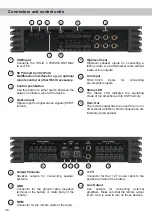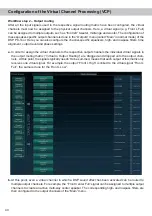
40
Workflow step 2 – Output routing
After all the input signals used in the respective signal routing matrix have been configured, the virtual
channels must now be assigned to the physical output channels. Here, a virtual signal (e.g. Front L Full)
can be assigned to multiple outputs, such as “front left” tweeter, midrange and woofer. The configuration of
these speaker-specific output channels is done in the “Outputs” menu (called “Main” in normal mode) of the
DSP PC-Tool. Here you can also configure the channel-specific equalizers, high- and lowpass filters, time
alignment, output level and phase settings.
a.
In order to assign the virtual channels to the respective output channels the individual virtual signals in
the output routing matrix (“Virtual to Output Routing”) are dragged and dropped onto the output chan
-
nels. At this point, the signals typically needn’t to be summed, means that each output of this matrix only
receives one virtual signal. For example, the output “Front L High” is linked to the virtual signal “Front L
Full”; the same is done for the Front L Low”.
b.
At this point, even a virtual channel in which a DSP sound effect has been activated can be routed to
multiple output channels. For example, the “Front Center Full” signal can be assigned to multiple output
channels to create an active multi-way center speaker. The corresponding high- and lowpass filters are
then configured in the output channels of the “Main” menu.
Configuration of the Virtual Channel Processing (VCP)









































